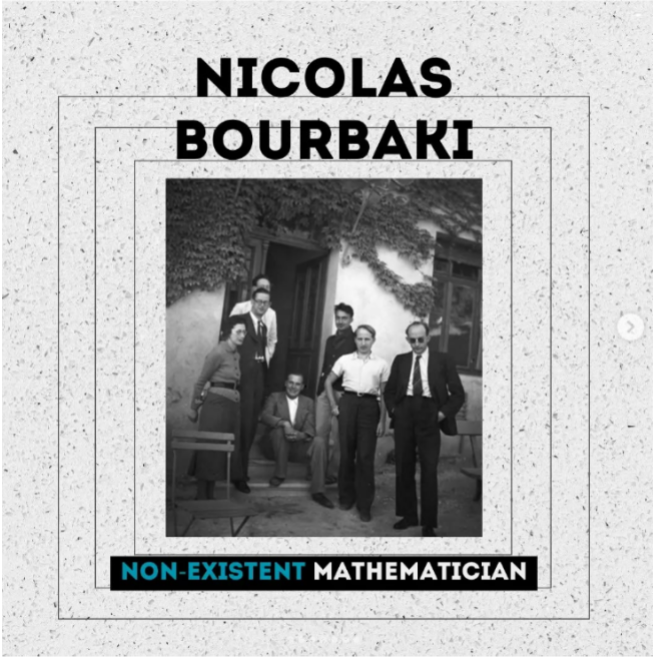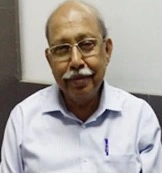One fine morning in 1969 we had just trooped into the ground floor class room at Rajabazar waiting for Prof. Purnangshu Ray our teacher for Mathematical Methods to join us. This was to be our introduction to modern algebra. He entered and went to the blackboard and wrote Bourbaki and said, ‘There is a group of mathematicians in France called Bourbaki and those who try to follow them turn out to be …’, wiping out the last letter ‘i’. We were always in awe because he, a favourite of S.N. Bose had as his Ph.D. supervisor, Abdus Salam. Later, we figured out more about this group.
In the aftermath of World War I, there was a certain nationalist impulse to save French mathematics from decline, especially in competition with Germany. As Dieudonné stated in an interview, ‘Without meaning to boast, I can say that it was Bourbaki that saved French mathematics from extinction.’ While teaching at the University of Strasbourg, Henri Cartan complained to his colleague Andre Weil of the inadequacy of available course material, which prompted Weil to propose a meeting with others in Paris to collectively write a modern analysis textbook. The group resolved to collectively write a treatise on analysis, for the purpose of standardising calculus instruction in French universities. The project was especially meant to supersede the text of Edouard Goursat, which the group found to be badly outdated. The founders were also motivated by a desire to incorporate ideas from the Gottingen school, particularly from exponents like Hilbert, Noether and B. L. van der Waerden. Bourbaki founder Andre Weil remarked in his memoir Apprenticeship of a Mathematician that France and Germany took different approaches with their intelligentsia during the war: while Germany protected its young students and scientists, France instead committed them to the front, owing to the French culture of egalitarianism.

Weil remembered an ENS student prank in which an upperclass man posed as a professor and presented a ‘theorem of Bourbaki’; the name was later adopted.
After graduating from the ENS and obtaining his doctorate, Weil had taken a teaching stint at the Aligarh Muslim University in India. While there, Weil met Damodar Kosambi, who was engaged in a power struggle with one of his colleagues. To help Kosambi establish intellectual superiority over his colleague, Weil suggested that Kosambi write an article with material attributed to one ‘Bourbaki’, in order to show off his knowledge to the colleague. Kosambi warmed up to the suggestion, and in 1931, attributed the material discussed in the article to ‘the little-known Russian mathematician D. Bourbaki, who was poisoned during the Revolution’. It was the first article in the mathematical literature with material attributed to the eponymous ‘Bourbaki’. The paper was named ‘On a Generalization of the Second Theorem of Bourbaki’ Kosambi, wrote:
I was not aware that a little-known Russian author, D. Bourbaki, who died of acute lead poisoning during the revolution, had anticipated part of these results and pointed out a way to their extension. I shall not go into details here, for an excellent résumé and critique has been published recently by Lusternik and Schnirelmann. But it will be clear to geometers acquainted with last-named paper that I merely proceed by discarding all three of the ‘Vysokoblagodaren’ axioms. Topologicheskie Metody v Variatsionnykh Zadachakh. Math.-mech. Forschungsinstitut, Moskau, 1930, pp. 69–73. I am indebted to Dr. A. Weil for this important reference, and for permission to use his private reprint. I understand that Schnirelmann’s work is shortly to be published in German, and this will undoubtedly fill a considerable gap in the existing literature. It is also highly desirable that Bourbaki’s posthumous papers, at present lodged with the Leningrad Academy, should be published in full. Unofficial reports claim that Bourbaki was shot after the Minkhii Znak affair with other members of the ‘Russko-Angliskii Slovar.’ The ‘Miniki znak’ (little sign) affair, also known as the ‘small-sign affair’, refers to a series of events during the Russian Revolution.
Weil’s stay in India was short-lived; he attempted to revamp the Mathematics Department at Aligarh, without success. The university administration planned to fire Weil and promote his colleague Vijayraghavan to the vacated position. However, Weil and Vijayaraghavan respected one another. Rather than play any role in the drama, Vijayaraghavan instead resigned, later informing Weil of the plan. Weil returned to Europe to seek another teaching position. He ended up at the University of Strasbourg, joining his friend and colleague Henri Cartan.
The little prank from the ENS upperclassman was slowly taking a form of its own. Little did they know that this would kick-start a new discourse. The name of Bourbaki first appeared in the Kosambi paper. So, what was so special about this particular publication? As described by André Weil, the prank was designed to deflate a senior colleague’s ego, presumably by demonstrating the greater familiarity that Kosambi had with modern methods and the then current literature. The rest of the paper is serious enough and points to Kosambi’s interests in differential geometry which were to preoccupy him for the next twenty years. Schnirelmann’s work continues to be of interest. Well, here’s the catch: the mathematician named Bourbaki did not exist! What is even more fascinating is that Bourbaki’s name in this paper was just the beginning. Following this, ‘Bourbaki’ revolutionised the field of pure mathematics by publishing a series of influential books and papers.
If Bourbaki did not exist, who was publishing all this mathematical literature? Why did Kosambi attribute his work to a mathematician who did not exist? There are so many questions and so many mysteries to uncover here. This is the story of Nicolas Bourbaki: the mathematician who never lived and is the collective pseudonym of a group of mathematicians, predominantly French alumni of the Ecole normale suerieure(ENS). Although former members openly discuss their past involvement with the group, Bourbaki has a custom of keeping its current membership secret. Founded in 1934–1935, the Bourbaki group originally intended to prepare a new series of textbook in analysis collectively as the Elements of Mathematics, meant to treat modern pure mathematics. Topics treated in the series include set theory, abstract algebra, topology, analysis, Lie groups and Lie algebras. The group is also associated with the Seminaire Bourbaki, a regular series of lectures presented by members and non-members of the group, who also publish and disseminate written documents. Bourbaki maintains an office at the ENS. Ninety years of continuous scientific activity, the Bourbaki group, although still somewhat confidential, and whose members—renewed over time—endeavor to publish a structured presentation of the discipline in the form of a monumental treatise.

Ashoke Ranjan Thakur is former Vice-chancellor, West Bengal State University, Kolkata, a specialist on mathematical and biophysical studies of macromolecules.

